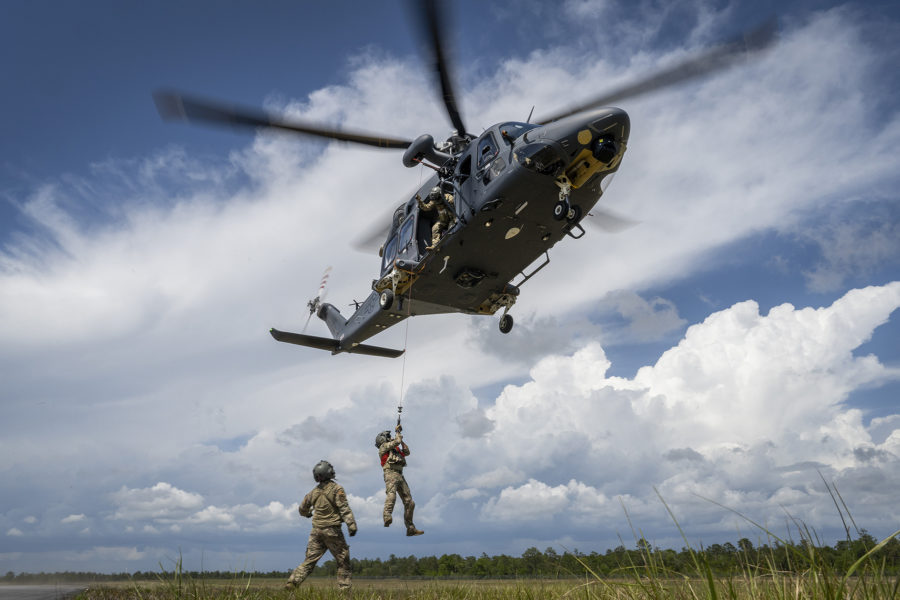As the Air Force gets ready to put the new MH-139A Grey Wolf helicopter through initial operational test and evaluation—a key step before full-rate production—the Pentagon’s test director is warning that the aircraft still faces important deficiencies that could cause it to not meet operational requirements.
The MH-139A—Boeing’s adaptation of the civil Leonardo AW-139—has issues with dust ingestion, software, a redesigned gun mount and spent shell casing management, seating restraints and the seating layout, among other concerns, the office of the Director of Operational Test and Evaluation said in its 2024 annual report. An electromagnetic pulse test, required for entry into initial operational testing, also still hasn’t been done, the report noted.
While testing is set to begin this quarter, the report said the assessment may have to be delayed if the Air Force and Boeing can’t correct the problems.
The Air Force has largely completed developmental testing and made progress in addressing other previously noted deficiencies, testers acknowledged, including issues with the automatic flight control system, sensor displays, and crosswind takeoffs.
“But performance concerns remain that present a risk to MH-139A meeting operational effectiveness requirements,” the report states.
Among them, the engine has a tendency to ingest dust and debris, which could cause long-term maintenance issues. This issue showed up mainly during landings in austere areas and “degraded engine performance,” the report states. The Air Force is evaluating whether it needs to conduct additional tests, but the report suggested that this is the main issue putting the MH-139’s “suitability” in question.
That’s in addition to “previously reported concerns about engine maintenance caused by expansion of the aircraft flight envelope and higher power requirements.” Testers also noted a buildup of carbon on several parts of the aircraft’s engine, including its fuel nozzles, the report said.
Other issues include cabin seating constraints and commercially derived mission planning software, both of which are unresolved.
The helicopter mounts an M240 machine gun, and previously reported concerns about this weapon persist, the report states. These include weapon malfunctions, the need to design a new way to catch the spent-brass casings, and the ammunition feed system. “A gun mount redesign is in development but will not be completed prior to IOT&E,” the report said.
The helicopter’s intercom system, which lets the flight crew talk to personnel in the cabin, is expected to require a redesign, which will not be completed prior to IOT&E, the report noted.
There are survivability concerns as well.
“The original contractor-proposed fuel cell design did not meet the required self-sealing military requirements for vendor material qualification against the specified projectile threat,” the report noted, adding that “subsequent testing focused on the design’s ability to inhibit sustained dry bay fires.”
The Air Force has extended developmental testing to include some equipment changes. An additional radio is needed for Global Strike Command missions and must be integrated with the system.
The MH-139 is also “behind schedule on integrating contractor maintenance data into the Air Force Integrated Maintenance Data System,” which is required “to support both IOT&E and normal operations with fielded aircraft.”
To enter initial operational testing, Boeing needs to deliver “operationally representative aircraft; complete flight and maintenance technical orders with the new radio and environmental control system” and provide “fully trained flight crews and maintenance personnel.”
The first phase of cyber testing has been carried out by the Air Force Operational Test and Evaluation Center, and AFOTEC has submitted plans for further cyber testing, the report said.
The Air Force’s plans for the MH-139 have varied wildly in the last few years. The service initially planned a fleet of 84 aircraft to replace the aged UH-1N fleet. The helicopter was to transport troops across intercontinental ballistic missile fields under ground attack, provide other support for those widely dispersed locations, and carry VIP passengers as needed.
But due to budget constraints, the Air Force reduced the buy to 80 aircraft, then 74, then 36 in the fiscal 2025 budget, eliminating the VIP transport mission. Six developmental aircraft will join the fleet, however, making the new inventory objective 42 aircraft. The Air Force has contracted with Boeing for 26 aircraft so far. The Air Force is fully equipping all ICBM bases with planned MH-139s.
The DOT&E report recommended that the Air Force develop corrective action plans for all known deficiencies in the Grey Wolf and ensure that there are enough aircraft “in an operationally-representative configuration” available for IOT&E, along with trained flight and maintenance crews, maintenance support, and “all associated support equipment, consistent with approved concepts of operations.”
